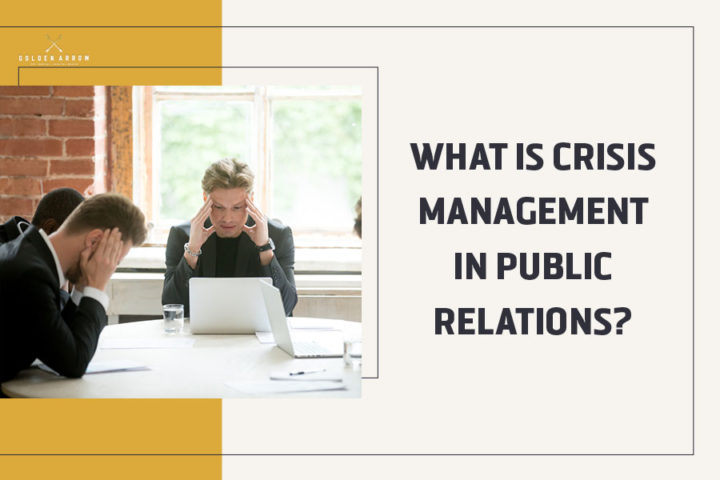In simple terms, crisis management refers to the process of how businesses and organizations handle a sudden emergency situation. The potential impact of a crisis can be managed by getting a firm grip on the narrative and taking appropriate action. Failure can sometimes result in devastating outcomes and damage stakeholders, so preventing and dealing with such challenges is critical. But what is crisis management in public relations, and how do you handle it?
There are several definitions for a crisis, each posing its unique threats, making crisis management vital. Due to the unpredictability of these threatening events, many businesses and organizations are trying to anticipate and prevent them. Public relations (PR) plays a pivotal role in crisis management as it’s the first line of defense for every company.
In this article, we’ll elaborate on the role of public relations in crisis management and the key elements of handling such issues. You’ll also discover what challenges stakeholders face when dealing with crisis scenarios and the best practices to overcome them.

Importance of Crisis Management in Today’s Media Landscape
The most basic definition of crisis management in public relations is identifying an organization’s and its stakeholders’ vulnerability and protecting it from unforeseen crisis events. This refers to the process of strategically handling and preventing or avoiding sudden situations that could potentially harm an organization’s reputation and very existence. It involves protective measures to prepare for unexpected events and reactive actions to address them once they occur.
Crisis situations are inevitable events that will affect most companies at some point. They can arise from a variety of sources, whether it’s a scandal, accident, or media backlash. With today’s fast-paced and interconnected media landscape, information spreads rapidly, thus enhancing the demand for effective PR crisis management.
Responding swiftly and effectively to emergency issues has never been as crucial for organizations. Failing to manage a crisis scenario can lead to various disadvantages for businesses and their stakeholders. From the potential risk of a negative reputation to the spread of misinformation, an unhandled crisis can significantly damage an organization’s image and credibility.
Key Elements of Crisis Management
During a crisis situation, a healthcare PR agency plays a vital role in communication among the organization. They’re responsible for informing and notifying all parties regarding the circumstances at hand, anticipated concerns and threats, protective hazards, and appropriate responses. These professionals are tasked with preserving a positive public image for the brand, which essentially builds trust and transparency in the company.
The procedure of handling a crisis situation involves PR professionals undertaking several key elements for managing the challenges. There are strategies and actions to be taken during each phase of a crisis, including the pre-crisis, crisis, and post-crisis stages. Here is a thorough breakdown of each one:
Pre-crisis stage
Although crisis scenarios are sometimes inevitable, effective PR management can help your company avoid and prevent them. Pre-crisis stage involves seeking to prevent and minimize any known risks that could lead to a crisis. This stage includes:
- Identifying and establishing a strategic set of activities that prevent and reduce the chance of a crisis or minimize its impact.
- Developing and implementing a preparation program along with establishing teams, protocols, and training during a crisis event.
Ultimately, the pre-crisis stage is a means of preventing a crisis case by creating a crisis management plan, selecting and training a management team, and conducting exercises to test the protocols.
Well-organized companies with advanced strategic plans for handling crisis situations should know exactly what to do when disaster strikes. Generating a list of possible crises, potential responses, and best- and worst-case scenarios can help the organization stay prepared. This includes avoiding repeat crisis situations and modifying existing protocols and procedures that best protect the brand.
Furthermore, assigning a company spokesperson, creating a list of available resources, as well as a step-by-step strategy to fight crises will ultimately allow you to handle the situation in a professional manner, avoiding the onset of additional damage.

During the crisis stage
Effective PR management is essential to prevent and minimize damaging impacts and effects if a crisis scenario strikes your organization. The stage during the crisis is the most critical step that will shape your future reliability and credibility with the audience. This step is a process of thorough planning and proper, immediate response, including:
- Alerting and notifying all interested parties regarding the crisis and everything associated with it. People will want to know what happens when disaster strikes, making immediate response and notification essential. If your organization stays quiet during these challenging times, misconceptions and misinformation can spread, harming your company and stakeholders.
- When preparing a response for a situation, PR must notify the status of an ongoing incident and determine whether the issue should be addressed or if it will resolve itself. Recognizing the seriousness and level of the problem is essential in generating an appropriate response. Crises are deemed threatening if they have the potential to negatively impact profits, generate undesirable media attention, or be detrimental to the company’s reputation.
- Essentially, the last step of this stage is to manage the crisis. This includes responding to the event, activating protective protocols and programs, preventing further damage, and reducing the impact and negative effects of the crisis.
Post-crisis stage
The post-crisis stage is the final step of revaluation, where essential follow-up communication is required. During this phase, an organization should analyze the crisis management program’s performance and notify stakeholders of the progression of the investigations, recovery efforts, and any corrective measures being taken.
Ultimately, the post-crisis stage suggests four steps: restore, return, learn, and upgrade. This includes:
- Account for and demobilize resources
- Initiate a post-incident recovery process
- Document and evaluate the effectiveness of the crisis management operations
- Upgrade and recommend improvements to the crisis management program
Once the crisis has passed, your organization should focus on returning to normal operations. Your main goal now is to repair and restore confidence in your company and products. Declaring the end of the crisis should indicate that your company is functioning normally with an even safer protocol following the crisis, rebuilding reputation and trust.
Furthermore, you need to evaluate the crisis’s impact, assess the crisis’s handling, recommend changes in crisis procedures, and learn from your experience. The final step is when effective resolutions are put into practice, and your PR management program is upgraded. Analyze the crisis management effort and convert it into lessons to integrate them into your crisis management system.
Challenges in Crisis Management
Dealing with threatening events can lead to several alarming challenges that need immediate attention and swift response. Crisis management poses unique issues to companies as social media amplification is a prominent concern for every organization.
In today’s digital age, with a fast-paced and interconnected media landscape, information can spread rapidly throughout various media platforms. This makes it challenging for organizations to control the narrative during a crisis, as disinformation can escalate quickly. It often outpaces the ability to verify facts, which challenges PR management to gather reliable data, ascertain the situation’s severity, and respond appropriately.
Furthermore, stakeholder engagement is vital to building trust and a positive audience relationship during a crisis, making it crucial to maintain confidence. Notifying the public and stakeholders of the situation and your organization’s response can demonstrate transparency and accountability. This will ultimately lead to stakeholder confidence and support.
While navigating these challenges may require agile strategies and crisis management, embracing a proactive approach is crucial when disaster strikes. Successfully navigating the intersection of social media and stakeholder confidence in crisis management demands a robust and swift response.
Best Practices and Strategies
In today’s world, businesses can face unexpected events that have the potential to disrupt their operation without a warning whatsoever. Crisis management strategies are crucial to protect a company’s stakeholders and ensure its survival. This involves swift response, strategic planning, and clear communication.
While establishing a preparation program with protocols and outlining roles and responsibilities is the first step, implementing the following guides is essential. Preparing your team for various crisis scenarios and ensuring a controlled and efficient response involves:
- Transparency and authenticity in communication – Maintaining transparency during a crisis means being honest and authentic. Openly sharing information concerning the situation and acknowledging challenges can build trust and credibility with stakeholders and help manage public perception.
- Leveraging media and technology – Leveraging media technology is paramount during a crisis. Since social media and online channels are powerful tools for spreading information rapidly, they offer an opportunity to stay ahead of the crisis narrative and have a controlled management plan. However, as disinformation can escalate quickly, companies must respond adequately and balance speed and accuracy.
- Employee training and internal communication – Training employees on communicating effectively during a crisis is vital for emergency management. Crisis communication training helps all interested parties understand the situation, identify the key challenges, choose the appropriate solution, and address all concerns.

Conclusion
In conclusion, public relations play a prominent role in crisis management among companies for communication. Whether it’s from natural disasters and cyberattacks or product recalls and scandals, PR helps strategically handle and prevent sudden situations that have the potential to harm an organization’s reputation or existence.
Knowing each phase of a crisis is vital for effective preparation and training, as disaster can strike at any moment. Additionally, acknowledging the challenges you might face during crisis management can help you avoid or even prevent them. Implying the best practices and strategies ensures an efficient and reliable plan for any crisis management scenario you might face.
Now that it’s clear what is crisis management in public relations and how to handle a crisis situation, you can safeguard your company and be prepared for any problem. Hopefully, this article has provided you with insightful information on the role of PR in crisis management.


